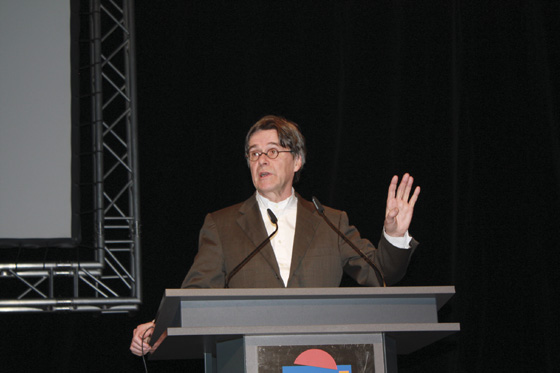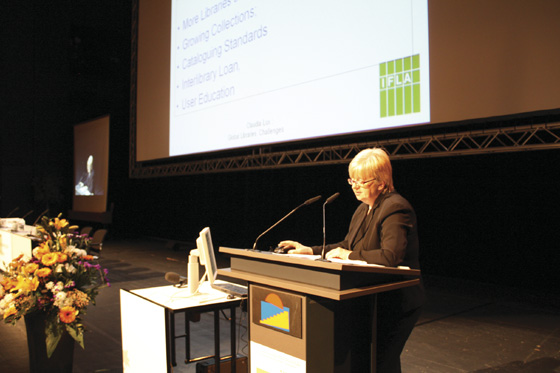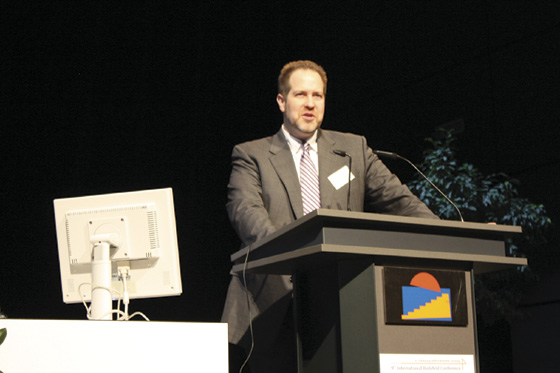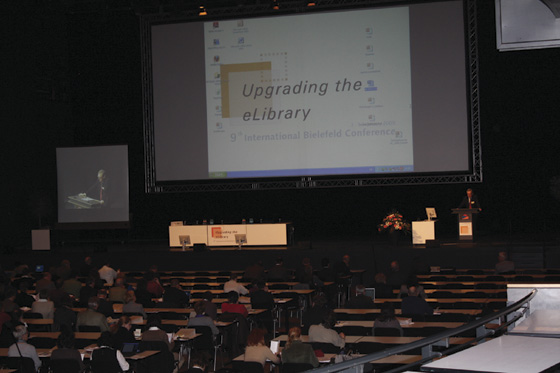Upgrading the eLibrary: Enhanced Information Services Driven by Technology and Economics
This article reports on the 9th International Bielefeld Conference ‘Upgrading the eLibrary: Enhanced Information Services Driven by Technology and Economics’, 3–5 February 2009, in Bielefeld, Germany. The conference focused on future challenges for libraries regarding the development of information services and infrastructures that meet the changing needs of scholarly communication, collaboration (e-science) and publication (open access) as well as new requirements regarding teaching and learning (virtual learning spaces). In addition, attention was paid to economic conditions and strategic positioning of libraries as a general framework for information services.
Bielefeld University Library in North Rhine-Westphalia, Germany, welcomed almost 400 information specialists from 30 countries to the 9th International Bielefeld Conference that took place from 3–5 February 2009. The theme this year was ‘Upgrading the eLibrary: Enhanced Information Services Driven by Technology and Economics’ [1].
The first International Bielefeld Conference took place in 1992, and since then it has proved to be one of the most popular forums for library and university managers from Europe and beyond.
The 9th International Bielefeld Conference focused on the ‘e-library’. Models for scientific communication and co-operation as well as user requirements have changed fundamentally. New technologies are emerging constantly, and economic conditions have not got better over the past years. These are the driving forces for upgrading the electronic library to an enhanced library, opening up both a world of new opportunities and of new constraints for progressing enhanced scholarly information services.
The programme committee, which included Michael Höppner, Director of Bielefeld University Library, Norbert Lossau, Director of Goettingen State and University Library, Germany, Wolfram Horstmann, CIO Scholarly Information, Bielefeld University, Ronald Milne, Director of Scholarship and Collections, British Library, and Hans Geleijnse, Director Library and IT-Services, Tilburg University, the Netherlands, was again able to provide a high profile for this conference. The committee invited renowned and trend-setting speakers from eight countries (Great Britain, the USA, the Netherlands, Denmark, Spain, Switzerland, Belgium, and Germany) who gave reports, in English or German, on current and future trends, concepts and experiences concerning the eLibrary.
The opening keynote speech of the first conference day, entitled ‘European Universities and Open Access’, was made by Sijbolt J. Noorda, chair of the European University Association Working Group on Open Access.

Figure 1: Sijbolt J. Noorda, European University Association, Open Access Working Group, UK, held the opening keynote on European universities and Open Access.
The starting point of his talk was a description of open access as part of the digital revolution and as a public service for the dissemination of knowledge. The digital age brings new arrangements for control and ownership, for selling and buying, and for dissemination and access. Open access to scholarly publications should be part of those arrangements. But the idealistic thought of having access to all information and publications faces a complex reality, and Open access does not mean the same to everyone. New business models are required that meet the needs of both researchers, publishers and the public. In March 2008 the European University Association adopted recommendations for a common strategy on public access to peer-reviewed academic publications. These recommendations ‘are based upon the following core premises: the university’s role and responsibility as guardian of research knowledge as a “public good”; the results of publicly funded research should be publicly available as soon as possible; and quality assurance peer review processes are preconditions for scholarly publishing and therefore are essential to be maintained in the digital publishing mode’ [2]. There are recommendations both for the University Leadership, the National Rectors’ Conferences and the European University Association. Universities are acting on these recommendations now. Noorda finished his talk with the statement that in academia the digital age has not yet reached its full potential and that European universities ought to be leading the way.
After this keynote speech there were three presentations on projects and initiatives at academic libraries.
Carol Tenopir from the University of Tennessee presented a method by which academic and research libraries can prove the value of their collections and services. Libraries increasingly are under pressure to demonstrate to their funders the return from their investment in the libraries. Return on investment (ROI) studies have been conducted for years in special libraries and public libraries, but both the investments and returns are different for academic libraries. At the University of Illinois at Champaign-Urbana a study was carried out on how the academic library’s investment in electronic journal collections benefits the grant writing process, which can have a direct financial return to the university. This study showed that for every dollar the university expended on the library, there was a return of four dollars. Afterwards the methodology used in this first study was refined and extended and then tested in universities in eight countries. Results from several studies and information about methodologies developed can be read in a white paper [3].
Juan Garcés from the British Library introduced the library’s different projects for mass digitisation of the Mediaeval and pre-Mediaeval manuscripts in its Western Manuscripts collections. He argued that this mass digitisation will not only transform the way readers will experience the British Library’s manuscripts, but also lead to an extension of the underlying service architecture. In addition, this endeavour will lead to the creation of an engagement environment for the digital surrogates that reflects existing and anticipated activities relating to digitised manuscripts.
After introducing this scenario, Garcés addressed three issues: 1. the integration of existing and developing digital resources relevant to the British Library’s manuscripts, 2. the facilitation of user-generated content, and 3. the extension and transformation of the Library’s existing services landscape. The British Library’s Greek papyri collection was used as a concrete example to illustrate these issues.
The ‘Knowledge Portal’ project was presented by Wolfram Neubauer, Library Director of the Swiss Federal Institute of Technology (ETH) in Zurich. The aim of the project is to represent all the diverse data collections on one single search platform, using modern portal and search engine technology [4]. The origin of this complex project was a survey the ETH library carried out in 2007. A sample of scientists was asked what they expected to get from their library and one thing was mentioned again and again: the researchers wanted one point of access to all the electronic library services and resources. In addition, the search processes should be as simple as possible. The ETH library accepted this outcome as a mandate to develop a single point of access to all electronic services provided by the library.
Wendy Pradt Lougee from the University of Minnesota Libraries concluded the first day with her keynote ‘Aligning the Library as Strategic Asset’. She described how a new multi-year plan at the University of Minnesota has re-positioned the libraries to align their activities with university priorities and strategic positioning, to focus resources toward engagement within the university community, and to leverage capacities for collaboration. The paradigms that shape and govern libraries and the broader information environment are in transition. Earlier notions of a library were focused on collections and the facilities and services that supported collection assets, but today the library’s strategy has to focus on the tasks and requirements of users. Library expertise and capacities to support these demands are essential. Studies of student and scholarly behaviour and critical analyses of learning and research processes at the University of Minnesota revealed a strong appetite for digital content and associated tools. The analyses also showed that the practices of exploiting those digital resources and of managing the raw materials of scholarship were no longer effective. The libraries’ response to the emerging demands of digital scholarship have included programmes and services that are embedded into user workflow, that address critical needs of discrete communities, and that enable the user to work effectively in digital contexts. Collaboration within the academy remains a primary strategy.
Isidro F. Aguillo Caño from the Cybermetrics Lab in Madrid opened the second conference day with his presentation ‘Your Institution’s Footprint in the Web’. Based on a description of inadequate business models for scholarly communication he proposed ways in which these drawbacks can be overcome in the digital age. As shown in the current evolution of the so-called Journals 2.0, a modern view should provide an extension of peer review (referees combined with open review) and improved access to additional material (including new media). In particular, he discussed web indicators that are designed not only to monitor the presence and impact of an individual or an organisation in web space but to promote a more open, global, societal, and detailed knowledge of the scholars’ organisation, activities and research results [5].
The workings of the scholarly communication system have changed dramatically in recent years, but until now relatively little has been known about the costs of this system as a whole. Michael Jubb from the Research Information Network in London presented a study which provides a rigorous analysis of the costs of all the activities involved in producing, publishing, distributing, securing access to and reading the 1.6 million peer-reviewed scholarly journal articles that are produced each year. This study also explored how, and by whom, these costs are being met [6]. In addition, it provided an analysis of the impact of possible changes to the system, including a shift to electronic-only publication; more general adoption of author-side payments to finance open access; cash payments to researchers who undertake peer review; and the implications of continued increases of the volume of articles published each year.
Anne Petry-Eberle from Daimler AG in Stuttgart described the transition from a physical library to a corporate online information centre in her company and how information services were outsourced. She also talked about implications for the library staff, particularly focussing on tasks like market investigation, market analysis, or decision making about the purchasing of online information resources.
The implications of Google Scholar and other search engines for users, societies, libraries and publishing houses were discussed by Hendrik Speck from the University of Applied Sciences Kaiserslautern, Germany. He explored the impact, options and risks of making information, data, and knowledge available via information retrieval systems, focusing on the transition of cultural values into economic assets.
Alongside the main programme three parallel sessions were offered on the second day of the conference that dealt with the following subjects: the library as (virtual) learning space; metrics for scholarly information; and advances in search, indexing and retrieval.
Digital information services are increasingly the medium of choice for students and this necessitates the creation and support of virtual environments. Many traditional libraries have moved to new kinds of spaces, such as learning centres, and e-learning has become a new term. Three presentations dealt with online services and how they can and should be supported by virtual learning environments. Norbert Meder from the University of Duisburg-Essen, Germany, reflected on educational paradigms for digital services in universities, focusing on web didactics as a new paradigm. Graham Bulpitt, Director of Information Services at Kingston University in London, talked about the challenges of moving from real to virtual learning environments and suggested how libraries can contribute to universities facing these challenges. Several learning centres were used as examples to illustrate these subjects. The future of e-books was discussed by Olaf Ernst from Springer Science+Business Media. He presented a study on the impact of Springer’s e-book collection in comparison to its print book activities. The study showed that despite some advantages of e-books, print books will not disappear. Print and electronic books can co-exist and will complement each other.
Over the last few years, the demand for an assessment of scholarly impact based on scientific publications has increased. Two presentations discussed this subject. An overview of current initiatives for collecting usage data and adding enhanced metrics for the evaluation of research was given by Frank Scholze from the Ministry for Science, Research and the Arts in the state of Baden-Württemberg, Germany. He also explained several evaluation methods such as the Journal Impact Factor, the Hirsch-index, and the Usage Factor. The participants also heard Dirk Lewandowski from the Hamburg University of Applied Sciences demonstrate how documents can be ranked in library catalogues. Unfortunately, the talk of Mogens Sandfær from the Technical Information Centre of the Technical University of Denmark, who had planned to present the national system for research assessment in Denmark, had to be cancelled.
The speakers at the third session were Alexander Mehler from the Johann Wolfgang Goethe-University Frankfurt a. M., Christian Hänger from Mannheim University Library, and Silke Schomburg and Jörg Prante from the Academic Library Center (‘hbz’) in Cologne who presented a retrieval model based on social ontologies, the possibilities of user generated content for libraries, and the use of search engine federations in libraries.
During the closing session of the second conference day several speakers presented ongoing activities and projects within e-science and e-research.
Martin Hofmann-Apitius from the Fraunhofer Institute for Algorithms and Scientific Computing, Germany, demonstrated how scientific biomedical publications can be analysed automatically for genes, their relationships to other genes, their role in the development of a disease and their role as potential targets for therapeutic cures. He also showed how advanced search engines are able to extract various terms in scientific text and how this can be used for modelling of diseases and simulation of disease-relevant molecular networks. At the same time he illustrated that it will still take time before researchers can use text analytics for direct modelling and simulation in the life sciences.
An overview of projects and services for the e-humanities was presented by Heike Neuroth from the Max Planck Digital Library. Over the last few years, not only has e-science served as a new buzzword, but the term e-humanities has also been established. e-Humanities involves developing shared services, tools and infrastructures based on new technologies and thus allowing new forms of cooperation and collaboration. Sharing of resources like research data, (digitised) content, tools, computational and storage hardware etc., is one of the great opportunities of e-humanities infrastructures. The German projects TextGrid and eSciDoc were discussed in detail. TextGrid is part of the D-Grid initiative, funded by the German Federal Ministry of Education and Research. The aim of TextGrid is to create a community grid for the collaborative editing, annotation, analysis and publication of specialist texts. Building on existing expertise in the field of e-science and advancing towards the semantic grid, TextGrid partners are developing a comprehensive set of tools for researchers in philology, linguistics, and related fields [7]. eSciDoc is a joint project of the Max Planck Society and FIZ Karlsruhe, also funded by the German Federal Ministry of Education and Research. It aims at building an e-research platform for multidisciplinary research organisations. eSciDoc is developed specifically for use by scientific and scholarly communities to collaborate globally and in an interdisciplinary manner. It comprises a set of services and solutions that enable innovative e-science scenarios: scientists, librarians and software developers can work with research data, create novel forms of publications, and establish new ways of scientific and scholarly communication [8].
In the future, research will increasingly require the collaboration of globally distributed groups of researchers needing access to distributed computing, data resources and support for remote access to expensive, multinational specialised facilities such as telescopes and accelerators or specialist data archives. Lee Dirks, Director of Education & Scholarly Communication at Microsoft, talked about elements of this vision and explained the necessary ‘cyberinfrastructure’ for research environments that meet the needs of a global research community.

Figure 2: Lee Dirks, Education & Scholarly Communication/Microsoft External Research, Redmond, U.S., described the vision of a smart cyberinfrastructure for eResearch.
The talk by Herbert Van de Sompel from the Los Alamos National Laboratory Research Library in New Mexico that concluded this day had been eagerly awaited. He took an unusual approach, looking back at the past instead of into the future. He reflected on some of the most visible efforts he was involved in over the past ten years that shared the goal of transforming aspects of access to scholarly communication. Among others, he described innovative developments such as SFX, OpenURL, OAI-PMH, MESUR, and OAI-ORE.
The last conference day was opened by the president of IFLA (International Federation of Library Associations and Institutions), Claudia Lux, who talked about ‘eLibraries on the Agenda’. The role of libraries from ancient times to the 21st century formed the starting point for a discussion of global challenges for libraries in the digital age. In particular, aspects in relation to technologies, services, infrastructures, staff development and economic issues were discussed, but also cultural, social, political and environmental challenges and their impact on the future role of libraries in the knowledge-based society. Lux identified a great many challenges, but at the same time she stressed that a challenge also is an opportunity.
Then Elisabeth Niggemann, Director-General of the German National Library, presented ‘Europeana’, a project intended to create a virtual European library, aiming to make Europe’s cultural and scientific heritage accessible for all [9]. Europeana is a network funded by the European Commission under the eContentplus programme, as part of the i2010 policy. Originally known as the European digital library network (EDLnet), it is a partnership of a hundred representatives of heritage and knowledge organisations and IT experts from all over Europe. The website Europeana.eu is a prototype that was launched in November 2008 by Viviane Reding, European Commissioner for Information Society and Media. Through the website internet users get access to two million books, paintings, maps, photos, archival documents, music, films, TV broadcasts and other digital items from national libraries and cultural institutions of the 27 EU Member States. More than 1000 archives, museums and libraries have provided digitised material. Europeana Version 1.0 is being developed and will be launched in 2010 with links to over six million digital objects.

Figure 3: Claudia Lux, President of IFLA, characterised the global library challenge.
Leo Waaijers, former manager of the SURF Platform ICT and Research and currently working as an independent consultant in the Netherlands, talked about open access institutional policies and strategies. Worldwide, there are about 3800 open Access journals registered, and about 20% of approximately 4000 universities and 1000 R&D institutes may have signed some form of open access manifesto (e.g., the Budapest Open Access Initiative, the Berlin Declaration or the Petition to the European Commission). But so far only 60 institutions have adopted a mandate to make the results of publicly funded research openly accessible. In this connection, the Open Access Recommendations adopted by the European University Association were mentioned again [2].
A description of various types of support that information professionals could provide for e-research and e-science was given by Joan K. Lippincott, Associate Executive Director of the Coalition for Networked Information. In particular, she discussed how librarians could assist with the development of metadata, implementation of interoperability, and assurance of long-term preservation of data. She also outlined models for the implementation of this type of support, and discussed the skill sets needed by information professionals in this environment. Several projects and initiatives were presented, such as the UK Digital Curation Centre [10], the UK Data Share project [11], the Canadian Research Data Strategy Working Group [12] and the Australian ARCHER Project [13].
Infrastructures for e-science and e-research were a further area of interest at the conference. Digital information and the increasing amount and availability of the data on which it is based have changed scholarship fairly dramatically. But no adequate infrastructure has yet emerged. Rudi Schmiede from the Darmstadt University of Technology, Germany, discussed these issues and talked about the essential elements of an infrastructure for scholarly information.

Figure 4: Almost 400 information specialists from 30 countries attended the 9th International Bielefeld Conference.
Anne Lipp from the German Research Foundation (DFG) described the contribution the DFG can make towards e-science and e-research environments. Based on the foundation’s vision that researchers should have free access to digital publications, primary research data, and virtual research environments, this presentation focused on current projects that support this vision. In particular, it put emphasis on topics such as national licensing, digitisation, and open access publishing.
The last talk of this conference was given by Mario Campolargo of the European Commission. His presentation, ‘Europe Shaping 2020’s Science: e-Infrastructures for Scientific Data’ focused on the strategic role of infrastructures in transforming the information-based society into a knowledge-based society. In the particular case of scientific data e-infrastructure, the objective is to develop an ecosystem of European digital repositories, federating and adding value to national and discipline-based repositories and to respond in this way to the request from EU member states to improve access to scientific information.
The closing résumé of the conference by Hans Geleijnse, Director Library and IT-Services at Tilburg University, has become a tradition. In an excellent manner, he summed up the most important topics of the conference and provided an outlook on the future challenges. To use his words: ‘The library is alive, but has to speed up to provide enhanced services and be relevant tomorrow!’
The International Bielefeld Conference 2009 provided insights into the future of e-libraries, based on the threefold interdependency of service, technology, and economics. Digital publications have changed information behaviour to a large extend, but also scholarly work and communication, so that the e(lectronic) library that is providing both print and electronic collections no longer meets all user requirements. In the future, information services must be integrated directly into virtual learning and research environments in order to support learning processes and scientific communications in an optimal way. Therefore at the moment we are observing a metamorphosis from the electronic library to an enhanced library meeting the emerging demands of e-science and e-learning.
The conference talks and discussions showed that there are many developments, ideas and activities related to scholarly communication and access. Institutional repositories, digitisation, the involvement of libraries in e-research and e-science, information infrastructures and the value of libraries for their stakeholders were discussed, as well as the consequences of this for library professionals.
The conference hosted an exhibition of more than 35 leading and well-known service providers, publishing houses, and producers of library software and communication technology.
The conference presentations are available at http://conference.ub.uni-bielefeld.de/2009/programme/. The proceedings of the conference will be published in Library Hi Tech.